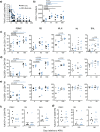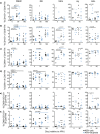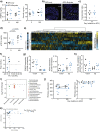Butyrate administration is not sufficient to improve immune reconstitution in antiretroviral-treated SIV-infected macaques
- PMID: 35523797
- PMCID: PMC9076870
- DOI: 10.1038/s41598-022-11122-x
Butyrate administration is not sufficient to improve immune reconstitution in antiretroviral-treated SIV-infected macaques
Abstract
Defective gastrointestinal barrier function and, in turn, microbial translocation have been identified as significant contributors to persistent inflammation in antiretroviral (ARV)-treated people living with HIV. Metabolic supplementation of short-chain fatty acids (SCFAs), generally produced by the commensal microbiome, may improve these outcomes. Butyrate is a SCFA that is essential for the development and maintenance of intestinal immunity and has a known role in supporting epithelial integrity. Herein we assessed whether supplementation with the dietary supplement sodium butyrate would improve immune reconstitution and reduce inflammation in ARV-treated, simian immunodeficiency virus (SIV)-infected rhesus macaques. We demonstrate that butyrate supplementation does not significantly improve immune reconstitution, with no differences observed in systemic CD4+ T-cell frequencies, T-cell functionality or immune activation, microbial translocation, or transcriptional regulation. Our findings demonstrate that oral administration of sodium butyrate is insufficient to reduce persistent inflammation and microbial translocation in ARV-treated, SIV-infected macaques, suggesting that this therapeutic may not reduce co-morbidities and co-mortalities in treated people living with HIV.
© 2022. The Author(s).
Conflict of interest statement
The authors declare no competing interests.
Figures




Similar articles
-
IL-21 and probiotic therapy improve Th17 frequencies, microbial translocation, and microbiome in ARV-treated, SIV-infected macaques.Mucosal Immunol. 2016 Mar;9(2):458-67. doi: 10.1038/mi.2015.75. Epub 2015 Aug 19. Mucosal Immunol. 2016. PMID: 26286233 Free PMC article.
-
Differential Dynamics of Regulatory T-Cell and Th17 Cell Balance in Mesenteric Lymph Nodes and Blood following Early Antiretroviral Initiation during Acute Simian Immunodeficiency Virus Infection.J Virol. 2019 Sep 12;93(19):e00371-19. doi: 10.1128/JVI.00371-19. Print 2019 Oct 1. J Virol. 2019. PMID: 31315987 Free PMC article.
-
Antibody-Mediated CD4 Depletion Induces Homeostatic CD4+ T Cell Proliferation without Detectable Virus Reactivation in Antiretroviral Therapy-Treated Simian Immunodeficiency Virus-Infected Macaques.J Virol. 2018 Oct 29;92(22):e01235-18. doi: 10.1128/JVI.01235-18. Print 2018 Nov 15. J Virol. 2018. PMID: 30185596 Free PMC article.
-
Microbial translocation in the pathogenesis of HIV infection and AIDS.Clin Microbiol Rev. 2013 Jan;26(1):2-18. doi: 10.1128/CMR.00050-12. Clin Microbiol Rev. 2013. PMID: 23297256 Free PMC article. Review.
-
I've looked at gut from both sides now: Gastrointestinal tract involvement in the pathogenesis of SARS-CoV-2 and HIV/SIV infections.Front Immunol. 2022 Aug 12;13:899559. doi: 10.3389/fimmu.2022.899559. eCollection 2022. Front Immunol. 2022. PMID: 36032119 Free PMC article. Review.
Cited by
-
From dysbiosis to defense: harnessing the gut microbiome in HIV/SIV therapy.Microbiome. 2024 Jun 21;12(1):113. doi: 10.1186/s40168-024-01825-w. Microbiome. 2024. PMID: 38907315 Free PMC article. Review.
-
Dual role for microbial short-chain fatty acids in modifying SIV disease trajectory following anti-α4β7 antibody administration.Ann Med. 2024 Dec;56(1):2315224. doi: 10.1080/07853890.2024.2315224. Epub 2024 Feb 14. Ann Med. 2024. PMID: 38353210 Free PMC article.
-
2-Hydroxypropyl-β-Cyclodextrin Treatment Induces Modest Immune Activation in Healthy Rhesus Macaques.J Virol. 2023 Jul 27;97(7):e0060023. doi: 10.1128/jvi.00600-23. Epub 2023 Jun 20. J Virol. 2023. PMID: 37338342 Free PMC article.
-
Untangling the role of the microbiome across the stages of HIV disease.Curr Opin HIV AIDS. 2024 Sep 1;19(5):221-227. doi: 10.1097/COH.0000000000000870. Epub 2024 Jul 24. Curr Opin HIV AIDS. 2024. PMID: 38935047 Free PMC article. Review.
-
It's all in the gut: the central role of the gut and microbiome in preventing disease progression in simian immunodeficiency viruses infected African nonhuman primates.Curr Opin HIV AIDS. 2025 Mar 1;20(2):124-132. doi: 10.1097/COH.0000000000000911. Epub 2025 Jan 8. Curr Opin HIV AIDS. 2025. PMID: 39774258 Free PMC article. Review.
References
Publication types
MeSH terms
Substances
LinkOut - more resources
Full Text Sources
Medical
Research Materials

